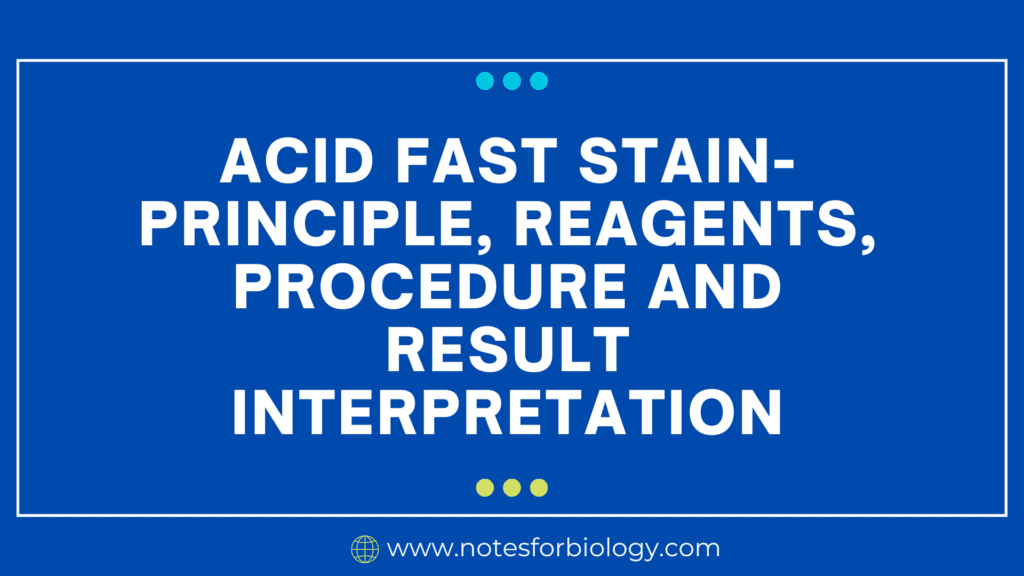The Acid Fast Stain is a scientific method for identifying acid-fast microorganisms such as Mycobacterium tuberculosis. The theory behind this stain is based on particular bacteria’s capacity to maintain a red dye known as carbol fuchsin even after being treated to an acid-alcohol decolorizer.
Table of Contents
What is Acid Fast Stain?
The Acid Fast Stain, commonly known as the Ziehl-Neelsen stain, is a differential staining method used to detect acid-fast organisms, particularly those from the Mycobacterium genus. This staining approach takes use of the peculiar properties of some bacterial cell walls, which contain large levels of mycolic acid, a waxy compound that renders them resistant to ordinary staining processes.
Principle of Acid Fast Stain
When a bacterial smear is soaked with carbol fuschin (primary stain) and heated, the stain penetrates the bacterial cell wall. As a result, bacteria appear reddish. Because of the presence of mycolic acid and a high lipid content, the acid fast bacteria retain the primary stain even after the decolorization procedure, whereas the non acid fast bacteria are decolored. When the smear is inundated with methylene blue (counter stain), the decolorized non-acid-fast bacteria absorbs it and becomes blue. The acid fast stain bacterial group, on the other hand, cannot accept the counter stain because they have carbol fuschin stain in their cell wall, causing them to look red.
Required reagents
Ziehl Neelson Carbol – Fuchsin (primary stain).
Acid Fast Decolorisation (Acid Alcohol)
Methylene Blue
Required apparatus
1. Acid fast kit (with reagents)
2. Bunsen Burner
3. Slides
4. Glass Rods
6. Inoculating loop
7. Mycobacteria culture
8. Microscope (oil immersion objective)
Procedure
1. Create a heat-fixed smear of the sample on a glass slide.
2. Cover the smear with carbol fuchsin, the principal stain.
3. Gently heat the slide until it steams, about 5 minutes. This allows the dye to enter the bacterial cells.
4. Rinse the slide with water to remove any excess discoloration.
5. Decolorize the slide with acid-alcohol. This procedure eliminates the stains caused by non-acid-fast bacteria.
6. Rinse the slide with water to end the decolorization process.
7. For approximately 1 minute, counterstain the slide with methylene blue.
8. Rinse the slide in water to remove any excess counterstain.
9. Blot the slide dry before inspecting it under a microscope.
Result Interpretation
Acid-fast bacteria appear red or pink because they retain carbol fuchsin. Examples include Mycobacterium TB and Mycobacterium leprae.
Non-acid-fast bacteria appear blue or green, depending on the counterstain employed, since they are decolored by acid-alcohol and take up the counterstain.
Examples
ACID-FAST BACTERIA: Mycobacterium tuberculosis, M.phlei, M. Leapre, etc.
NON-ACID FAST BACTERIA: E.coli, Staphylococcus aureus, etc.
Advantages of Acid Fast Stain
1. Specific Identification: The Acid Fast Stain is very specific for detecting acid-fast microorganisms like Mycobacterium tuberculosis. It distinguishes certain germs from others, allowing for more accurate diagnosis.
2. Rapid Detection: Because the stain may be applied in a short amount of time, acid-fast bacteria can be detected quickly. This is critical for detecting and treating infectious infections quickly.
3. High Sensitivity: The Acid Fast Stain is extremely sensitive, detecting even minute amounts of acid-fast bacteria in a sample. This is especially crucial in detecting TB, where low bacterial loads may exist.
4. Differentiation: The stain aids in separating acid-fast bacteria from non-acid-fast bacteria, providing for a clear separation between the two species. This difference is useful in microbiological and therapeutic situations.
5. Compatibility with Clinical Samples: The Acid Fast Stain is compatible with a variety of clinical samples, including sputum, tissue biopsies, and bodily fluids. Its adaptability makes it a useful tool for identifying illnesses caused by acid-fast bacteria.
6. Cost-Effective: The stain is less costly than other diagnostic methods. This low cost makes it accessible to laboratories with limited resources, especially in low-resource settings.
7. Widely Accepted Procedure: The Acid Fast Stain is a well-known and commonly used procedure in microbiology. Its dependability and accuracy have been proven throughout the years, making it a reliable method for detecting acid-fast bacteria.
Disadvantages of Acid Fast Stain
1. Time-consuming: Because it requires numerous processes and heat fixation, the Acid Fast Stain treatment might take longer than other staining procedures.
2. Skill-Dependent: The Acid Fast Stain must be applied correctly to achieve the desired results. Inaccurate procedure or incorrect interpretation of data might result in false positives or negatives.
3. Limited Use: Acid Fast Stain is unique to acid-fast bacteria and may not be useful in detecting other microorganisms in a sample.
4. Decolorization Sensitivity: Acid Fast Stain’s decolorization stage is crucial. Over-decolorization can result in false negatives, whilst under-decolorization might result in false positives.
5. Contamination Risk: The staining procedure includes handling potentially infected materials, which increases the risk of contamination for both the operator and the laboratory environment.
6. Variable Results: Acid Fast Stain results might vary depending on the quality of the sample, staining procedure, and operator skill, resulting in inconsistent findings.
7. Limited Quantitative Information: Acid Fast Stain gives qualitative information regarding the presence or absence of acid-fast bacteria, but not quantitative data like bacterial load.
Overall, the Acid Fast Stain is an important differential staining method in microbiology, especially for recognizing mycobacteria such as Mycobacterium TB and Mycobacterium leprae. This approach separates acid-fast bacteria from non-acid fast bacteria by taking advantage of their characteristic waxy, lipid-rich cell walls. The process consists of staining with carbol fuchsin, decolorizing with acid-alcohol, and counterstaining with methylene blue or malachite green. Acid fast bacteria maintain the red color of carbol fuchsin, but non-acid-fast bacteria absorb the color of the counterstain. This staining method is essential in clinical diagnosis and research because it aids in the accurate identification and investigation of pathogenic mycobacteria.
Frequently Asked Questions (FAQ)
What is the objective of an Acid Fast Stain?
The Acid-Fast Stain is used to detect acid-fast bacteria, such as Mycobacterium species, which cause illnesses including TB and leprosy. These bacteria have unusual cell wall characteristics that prevent acid-alcohol decolorization.
What are the main reagents used in Acid Fast Stain?
The main chemicals used are carbol fuchsin (primary stain), acid-alcohol (decolorizer), and a counterstain such methylene blue or malachite green.
Related Articles



